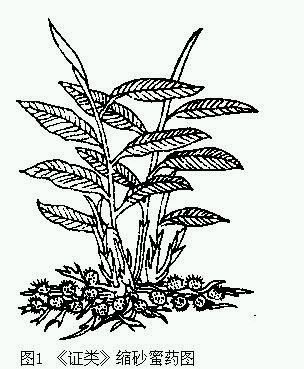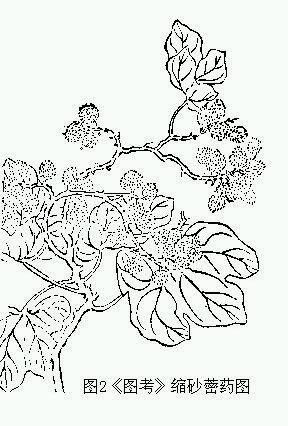| title | Villous Amomum Fruit |
| release time | 2006/9/8 |
| source | Jade Knock Studio |
| keyword | Amomum Villosum |
The dried mature fruit of Alpinia oxyphylla Miq., a plant of the ginger family, is primarily produced in areas such as Tunchang, Chengmai, Danzhou, Baoting, Qiongzhong, Baisha, Sanya, and Lingshui in Hainan. It is also produced in Xinyi and Yangjiang in Guangdong, Lingshan and Hengxian in Guangxi, Nan'an and Zhangzhou in Fujian, and Xishuangbanna in Yunnan.
Materia medica research suggests that the medicinal variety of Alpinia oxyphylla has remained unchanged from ancient times to the present, always being Alpinia oxyphylla, with the best quality coming from Guangdong and Hainan.
bubble_chart Variety Identification
It is unclear why Sharpleaf Galangal Fruit got its name. The Bencao Gangmu quotes the "Zhizhi Fang" as saying: "The heart is the mother of the spleen. Eating not only harmonizes the spleen, but fire can generate earth. Therefore, heart medicine should be included in spleen and stomach medicine to achieve mutual benefit. Thus, the ancients often used Alpinia oxyphylla in eating medicine, as it benefits fire within the earth." Hence, Li Shi-zhen explained: "The spleen governs wisdom. This substance can benefit the spleen and stomach, hence its name is similar to that of longan, which is also called Yizhi (benefiting wisdom)." This explanation seems somewhat far-fetched. Additionally, the "Tongzhi" quotes Su Shi as saying: "Hainan produces Alpinia oxyphylla, whose flowers and fruits grow in long spikes, divided into three sections. The ripening of the fruit indicates the year's harvest. The lower section predicts the early harvest, and the upper and middle sections do the same. A bountiful year means the fruit ripens, while a poor year means it does not, as it is rare for all three sections to ripen together. As a medicine, it only benefits wisdom. Could its name come from its ability to predict the year?" (The last sentence in "Guang Qun Fang Pu" quotes "Dongpo Miscellaneous Records" as saying: "As a medicine, it treats qi and stops water, but does not benefit wisdom. Wisdom is not sought from medicine. Could its name come from its ability to predict the year?" This seems more plausible.) This explanation is particularly forced and may not be accurate.
Note that longan is also called Yizhi. The "Guangya·Shimu" states: "Yizhi is longan." The "Wu Pu Materia Medica" agrees. Ghost eye is also called Yizhi. The "Taiping Yulan" quotes the "Guangzhou Ji" as saying: "Ghost eye, Yizhi, cannot be eaten directly but can be made into a paste." Yizhi, longan, and ghost eye are all fruits of tropical plants and originate from barbarian lands. Examining the ancient pronunciation of "Yi" and "Zhi," both are in the same rhyme group (detailed in Wang Niansun's explanation in the "Guangya Shuzheng" under the Yizhi longan entry). Thus, the name "Yizhi" might be derived from local dialects, with the sound being recorded by listeners, and may not necessarily be related to enhancing wisdom.Alpinia oxyphylla is a southern plant, documented in various records of exotic flora and local chronicles from Lingnan since the Wei and Jin dynasties. The "Qimin Yaoshu" Volume 10, under the section "Five Grains, Fruits, Vegetables, and Herbs Not Produced in China," cites four texts regarding Alpinia oxyphylla. The "Guangzhi" states: "Alpinia oxyphylla leaves resemble ginger, over a zhang long. Its roots have small branches, eight to nine inches tall, without petals. Its fruits cluster together, as large as dates, with black flesh and white skin. The smaller seeds are called Alpinia oxyphylla, which can stop excessive saliva when held in the mouth. It is produced in Wanshou and also grows in Jiaozhi." The "Southern Grass and Trees" states: "Alpinia oxyphylla fruits are like brush tips, seven to eight fen long. Flowers appear in February, and fruits mature by May or June. They taste pungent and are fragrant when mixed with Wuwei. They can also be salted and dried." The "Yiwu Zhi" states: "Alpinia oxyphylla resembles coix seeds, about an inch long, like raisin tree seeds. It tastes spicy and is good to eat with alcohol." The "Guangzhou Ji" states: "Alpinia oxyphylla leaves resemble ginger, and its stems are like bamboo arrows. The fruits grow from the center, with ten seeds per fruit. The seeds are white and smooth inside. After removing the outer skin, it is cooked with honey to make a paste, tasting pungent."
The Alpinia oxyphylla mentioned in the above texts is undoubtedly Alpinia oxyphylla. The "Guangzhi" mentions "stopping excessive saliva when held in the mouth," which is the origin of its later use as an astringent and consolidating agent.Yizhi (益智) was officially recorded as a medicinal substance in the materia medica starting from the Bencao Shiyi (本草拾遺). However, it had already been mentioned in earlier texts such as the Bencao Jing Jizhu (本草經集注) and Xinxiu Bencao (新修本草). Chen Cang-qi (陳藏器) described its ability to "stop vomiting and hiccups." The Kaibao Bencao (開寶本草) added new effects, stating: "Sharpleaf Galangal Fruit (益智仁), pungent in taste and warm in nature, non-toxic. It primarily treats seminal emission, deficiency, fistula disease, and residual dribbling of urine. It tonifies qi, calms the spirit, replenishes deficiencies, stabilizes the triple energizer, and regulates various qi. For those with frequent urination at night, take twenty-four crushed pieces, boil with salt, and take it for remarkable efficacy."


In summary, the original plant of the Sharpleaf Galangal Fruit medicinal material has remained unchanged from ancient times to the present. What needs to be slightly explained is the medicinal illustration of Sharpleaf Galangal Fruit in materia medica. The Bencao Tujing describes: "The leaves resemble those of galangal, over a zhang long. Its roots produce small branches beside them, about seven or eight inches high, without leaves. The flower calyx forms a spike on top, as large as a jujube, with white skin and black kernels inside. The finer the kernels, the better." The Zhenglei Bencao depicts the "Leizhou Sharpleaf Galangal Fruit" medicinal illustration (Figure 1), which is quite accurate and can be fully identified as Alpinia oxyphylla. Subsequent works like Bencao Pinhui Jingyao and Bencao Mengquan all imitated this illustration. However, the Bencao Gangmu mistakenly altered the original parallel leaf veins to pinnate veins (Figure 2). Later, the Zhiwu Mingshi Tukao also seemed to follow the Gangmu with slight refinements, making the pinnate vein characteristics even more pronounced (Figure 3). From this, it is clear that Li Shizhen and Wu Qijun did not recognize Sharpleaf Galangal Fruit. The statement in the Tukao that "it is also found in Lushan today" (which likely originates from the "Lushan Ji") is unreliable.
【Historical Evolution of Authentic Production Areas】 The Kaibao Bencao states that Sharpleaf Galangal Fruit "is said in the Shanhai Jing to grow in the Kunlun (BL60) country." However, the Shanhai Jing does not contain this text, so it is likely a mistaken claim. From the previously cited literature, it appears that since the Wei and Jin dynasties, Sharpleaf Galangal Fruit has primarily been produced in Guangdong, Guangxi, Vietnam, and other regions. Su Song mentioned that "it is often found in the prefectures of Lingnan today." According to the Taiping Huanyu Ji, the states producing Sharpleaf Galangal Fruit were all within the Tang dynasty's Lingnan Circuit, including Gaozhou, Yulinzhou, Huazhou, Leizhou, Qiongzhou, and Jiaozhou. Among these, the Huazhou entry specifically states: "Lianshui and Wuchuan abound in Sharpleaf Galangal Fruit." Additionally, the Zhenglei Bencao illustrates the Leizhou Sharpleaf Galangal Fruit, and Su Shi, during his exile to Danzhou, documented this plant in writing. Therefore, it is evident that Sharpleaf Galangal Fruit from Guangdong and Hainan has always been of superior quality.In the 29th year of the Republic of China (1940), the "Regulations of the Medicinal Trade Association of Xijing City (Xi'an), Shaanxi" recorded: "Sharpleaf Galangal Fruit is produced in Fujian, Guangdong, Guangxi, and Annam (Vietnam)." Among these, the Sharpleaf Galangal Fruit from Hainan is particularly renowned for its high quality. The "Medicinal Production Analysis" states: "Sharpleaf Galangal Fruit is produced in the thirteen counties of Qiongya (Hainan), with Lingshui being the top grade. It is harvested in May and June." (At that time, the entire island of Hainan was divided into thirteen counties, hence the term "Qiongya Thirteen Counties.")
bubble_chart Other Related Items




